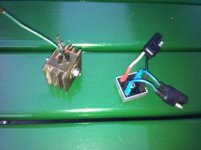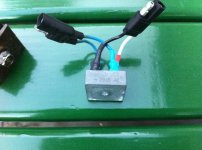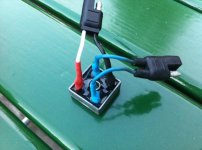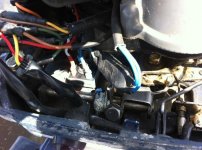AlwaysFixin - It would be a service to other owners if you thoroughly documented you procedure and posted it.
Ok. I did something a little different than was suggested because I chose to use a bridge rectifier that had the rectifiers encased in an aluminum block (which aided in both mounting and in cooling of the rectifiers and because I had some in my parts bin already).
A similar part would be:
http://www.radioshack.com/product/index.jsp?productId=12681237
The bridge had 4 connections: +, - and two labelled AC or ~
For those not familiar with these devices, the + and - hook up to the connector that proves power out to the exterior engine connector and fuse. I chose to use a slightly different connector than was there originally but if you want to reuse the old one, cut the wires from the old rectifier close to it to give you lots of wire and you should be good to solder the red (the side which goes to the fuse) to to the + on the bridge and the green to the - on the bridge. I installed colored heat shrink tubing over the wires before soldering them so I could slide them over the soldered connection after soldering to shrink on and insulate and identify the connections (red for +, black for -).
The two AC or ~ connections accept the AC provided by the two blue wires from the motor. Again, if you cut them close to the original rectifier to give you good length, slip heat shrink tube over the wires and then connect these to the two AC or ~ connectors and solder, slide the heat shrink over the soldered lugs and then shrink them, you should be good.
The other thing I did was to drill out the hole in the block a slight bit larger to fit the 6mm screw that held the original rectifier. I replaced the screw with a shorter one - one that stuck out about a 1/4 to 1/2 inch from the new block and then installed this rectifier in place of the old rectifier - of course being careful not to stress the wires too much. plugged the two connectors in as the original had been (blue into blue and red/green into red/green) and I now am back to having power generated to charge my boat batteries and power my running lights.
I have included some photos in the hopes they clarify some of my words.




I hope this helps some of you get a few electrons out of your old motors (given that Honda has decided to discontinue supplying the original part).





